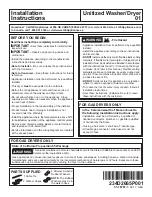
EN - 18
03/2012
Copyright © 2012, Fast ČR, a. s.
PART 5: WASHING DISHES / CUTLERY
Purchase dishes designated as dishwasher safe.
Use a gentle dishwashing detergent marked as "gentle on dishes". If necessary seek out further information
from the dishwashing detergent manufacturer.
For certain types of dishes select a lower temperature.
To prevent possible damage, remove glassware and cutlery from the dishwasher as soon as possible after
the end of the wash.
Unsuitable are:
cutlery with wooden, bone or mother-of-pearl handles;
plastic parts that are not heat resistant;
older cutlery with glued parts that are not heat resistant;
glued cutlery or dishes;
tin or copper dishes;
crystal glassware;
metal parts susceptible to corrosion;
wooden cutting boards;
dishes made from synthetic fi bres.
Partially suitable are:
some types of glass may corrode after several washes;
silver and aluminium cookware may become discoloured by the wash;
glazed patterns may fade if washed frequently.
NOTE:
Your dishwasher will achieve the best performance if you follow these instructions for inserting dishes
into the racks. The function and appearance of the racks and the cutlery basket may diff er depending on
the model of the dishwasher.
NOTE:
Do not place any items into the dishwasher soiled by cigarette ash, wax, varnish or paint.
When buying new dishes, check that they are dishwasher safe.
First remove remaining or burned on foods. It is not necessary to wash dishes under running water.
Insert the dishes into the dishwasher as follows.
Items such as cups, glasses, pots / pans, etc., should be placed bottom up.
Curved cookware and cookware with projections should be placed at an angle to allow water to freely
fl ow out.
Place dishes safely so that they cannot tip over.
Place dishes in such a way that the spraying arms can rotate freely during the wash.
NOTE:
Do not wash very small pieces in the dishwasher because they can easily fall out of the rack.
















































